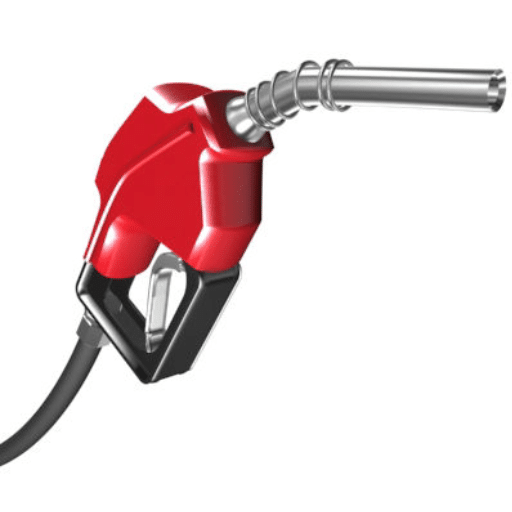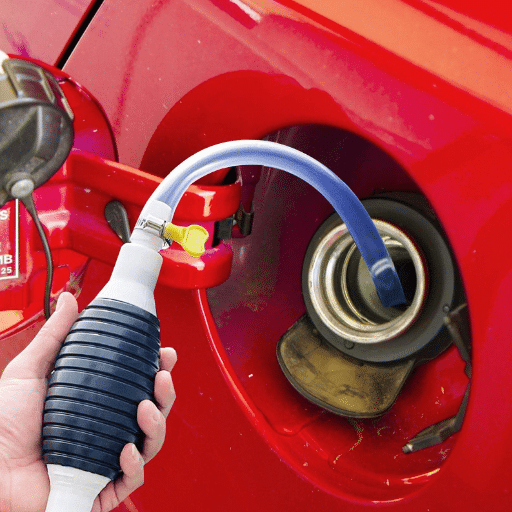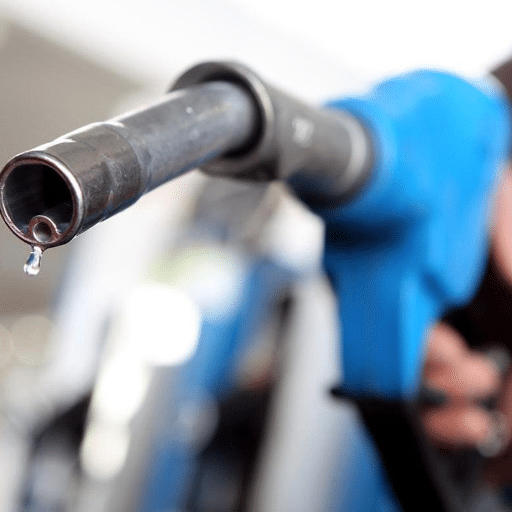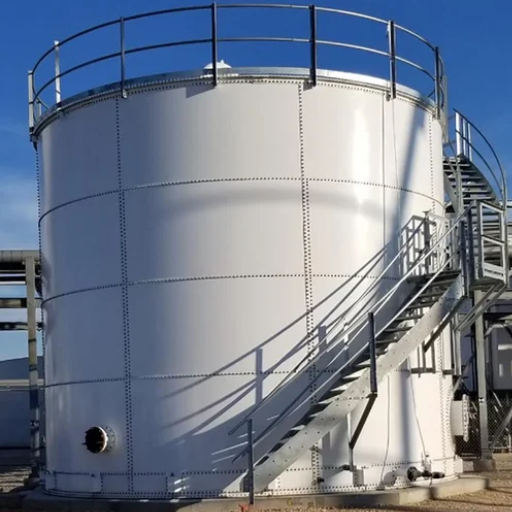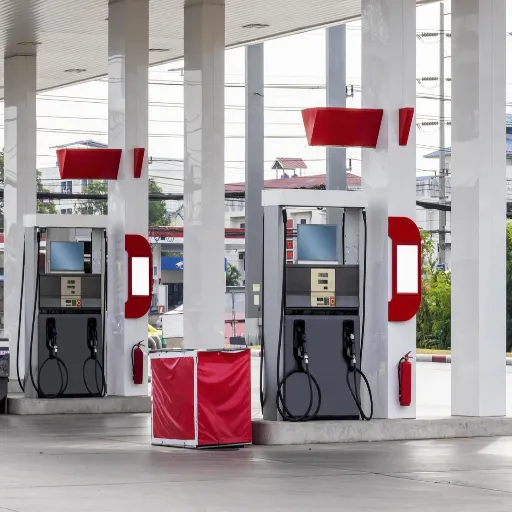Building a gas station is an ambitious yet fulfilling opportunity and one that comes with several considerations, chief among these being construction spending. Say you’re an entrepreneur entering the fuel retail business; hence, you will need to know the significant construction costs for long-term success. The article examines the various factors that contribute to the construction of a gas station, all within a very tight budget. From site selection and design planning through regulatory processes and material costs, you will gain practical insights and strategies that enable you to make informed decisions. Get ready to balance the three key elements —quality, efficiency, and cost —as you turn your dreams into reality.
Understanding Gas Stations
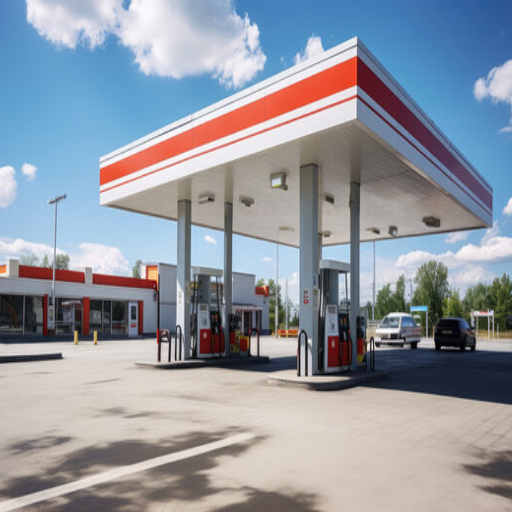
Gas stations serve as essential hubs for refueling vehicles and offer convenience services to travelers. A typical gas station features fuel pumps and storage tanks and often includes a convenience store offering food, drinks, and other essentials. A more modern gas station would also feature car washes, air pumps, and possibly even EV chargers to cater to the diverse needs of its customers. A gas station ranks as a top priority for complete fuel distribution, most securely and efficiently, while conforming to local regulations and meeting quantitative customer needs.
Types of Gas Stations
Full-Service Gas Stations: At a full-service gas station, attendants pump gasoline for customers, clean windshields, and, in some cases, even check tire pressure and oil levels. Convenience and personalized service are at the forefront in these stations, and as a result, fuel usually costs a few cents more.
Self-Service Gas Stations: As the most common type of gas station, self-service stations require customers to operate the pumps themselves. They promote affordability and efficiency, typically offering payment options such as card readers and mobile payment systems.
Automated Gas Stations: These are completely unmanned gas stations powered by technology, allowing customers to pay for and pump fuel independently, typically 24 hours a day. These are usually cost-effective, thus attracting customers who want to be in and out fast.
Truck Stops: Designed for the long-haul truck driver, truck stops are larger, equipped with heavy-duty fuel pumps, and offer showers, rest areas, and full-service restaurants, providing a one-stop solution for long-haul journeys.
Electric Vehicle Charging Stations: The arrival of electric cars has led to the installation of several charging stations that serve as charging points for EVs. These stations cater to owners of electric vehicles, offering medium- and fast-charging facilities that promote cleaner energy options.
Importance of Customer Convenience
Customer convenience plays a fundamental role in establishing today’s gas stations and EV charging hubs. Today’s consumers prefer quick, easy, and accessible services. Research indicates that 76% of customers prioritize convenience over price, which fosters customer loyalty and satisfaction. Mobile payments, pre-ordering for fuel via an app, and real-time availability updates for EV charging stations are examples of features contributing to the user experience.
In contrast, 80% of fuel sales in the U.S. are conducted by gas stations with convenience stores, indicating that ancillary services are crucial to revenue creation. Clean restrooms, high-quality food offerings, and Wi-Fi make stops enjoyable and efficient for travelers. For EV users, fast charging stands out as the foremost infrastructure need, with high-powered chargers capable of delivering 200 miles of range in approximately 20 minutes becoming increasingly popular. The synergy of all these factors blends a hub of convenience catering to the evolving requirements of tech-savvy, time-conscious customers.
Role of Convenience Stores in Gas Stations
Convenience stores play a crucial role in determining the success and profitability of modern gas stations. Industry data reveal that convenience stores generate revenues exceeding $250 billion annually in the United States alone. These stores serve as important retail venues where snacks, beverages, and small essentials can be purchased on the way, accounting for 60 percent of all in-store sales at the gas stations.
Main trends have seen consumers shifting towards health-conscious snacking, artisanal coffee, and fresh food options rather than their traditional prepackaged items. Effectively questioning many gas station convenience stores to broaden their food selections with fresh salad, sandwich options, and high-quality coffee to accommodate the burgeoning customer requests.
The integration of technology has only further cemented the importance of the convenience store compared to its gas-station counterparts. Self-checkout kiosks and mobile payments enable an expedited shopping experience, ultimately driving customer satisfaction and retention. Through loyalty programs and the potential for personalized promotions, convenience stores have entrenched themselves as necessary components of any gas station ecosystem.
The increasing importance of convenience stores is due to the rise of electric vehicles. While an EV user is charging their truck for 15 to 30 minutes, convenience stores offer an essential array of services and goods that generate incremental revenue during the charging stop. Along with the installation of a high-power charger in the gas stations, a well-equipped store forms a dual utility hub catering to the needs of fueling and retail.
Gas Station Construction Process
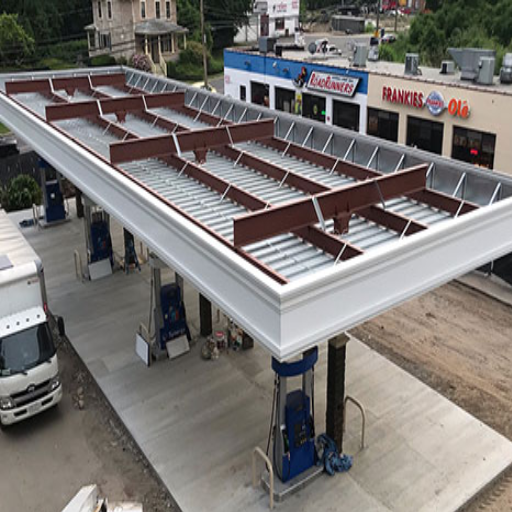
Planning and Design: Construction begins with in-depth planning and designing of the gas station. This phase involves selecting the ideal location, obtaining the necessary permits, and designing the layout according to safety standards and zoning regulations. Some key considerations include accessibility to and from highways, as well as the demand for fuel and convenience services in a given area.
Site Preparation: Once finalized, site preparation work is initiated. During this process, the land is cleared and leveled, with sound drainage systems provided. Then, the ground is prepared for the installation of underground fuel storage tanks. Sometimes, an environmental assessment is required to lessen any possible damage, such as soil contamination.
Construction and Installation: This phase involves building the leading convenience store, fuel pump stations, and canopy, along with any other facilities such as EV charging stations. Installation of the underground storage tanks follows; they safely hold the fuel. Piping is arranged to make connections between tanks and dispensing units. Thereafter, state-of-the-art safety and monitoring systems are incorporated.
Finishing and Operational Setup: Once this is done, installation of lighting, signage, security systems, and POS systems inside the convenience store takes place. This is followed by safety inspections before opening, which are done to confirm compliance with regulations. After passing the inspection, the gas station can go operational, dispensing fuel, EV charging, and retail products to its customers.
Steps in Building a Gas Station
Site Selection and Feasibility Study: The first step is to locate a strategic site for the gas station. Intersections or areas near highways are considered high-traffic points, thereby giving customers the maximum chance to access the place. A feasibility study is conducted to assess factors such as property size, zoning laws, nearby competition, and environmental impact. According to the latest industry figures, in urban areas, it is typically necessary for gas station construction to require parcels between 20,000 and 40,000 square feet to accommodate fueling stations, parking, and a convenience store.
On Permits and Approvals: Various permits are required at different levels for setting up a gas station, including environmental clearances, a construction permit, and a business license, among others. For instance, ecological norms would specify soil testing and the installation of leak detection and mobilization measures to control any contamination of the registered land and groundwater resources. This process may take several months, depending on the regional complexity and regulations.
Design and Engineering: This stage involves planning the structural layout, considering safety and zoning requirements. The design includes the fueling station with underground storage tanks, the convenience store design, and, more recently, EV charging infrastructure. Trends indicate that more renewable energy systems, such as solar panels, will be integrated to achieve better sustainability and cost reduction.
Construction and Installation: Once design approvals are attained, construction proceeds with site preparation, including grading and groundwork. The underground fuel tanks and pipelines are installed with strict conformance to industry standards, such as API (American Petroleum Institute) specifications. At the same time, foundation work proceeds for the convenience store and EV charging units. Current technologies also handle the installation of automated fuel payment systems and energy-efficient LED lighting, which are now standard for virtually all new stations.
Finalizing Operations and Safety Measures: Following construction, the station undergoes operational setup, including POS installations, retail stocking, and testing of all fuel and EV equipment. Safety inspections are conducted to ensure the proper operation of fire suppression systems and the integrity of fuel storage. Data from recent years indicates more than 55% of new gas stations now feature charging ports for electric vehicles. This reflects the dual nature of hybrid service centers, which cater to both conventional and electric vehicle clients.
Opening and Marketing Strategy: For the opening, the gas station needs to implement a marketing strategy to attract customers on the front end. Discounts, fuel promotions, and grand opening events are commonly used to attract customers. Now is a good time to implement loyalty rewards programs or mobile app integration to enhance retention and user experience.
In this way, by painstakingly following these steps, the construction and operation of a gas station can be carried out more efficiently and in a manner that conforms to modern demands and the goal of sustainability.
Choosing the Right Construction Company
Choosing the right construction company is a crucial step in successfully realizing a gas station project. First, the company should be evaluated in terms of its experience with constructing gas stations, including matters related to industry-specific requirements such as environmental regulations, underground tank installation, and safety measures. The more competent they are in working on such projects, the higher the quality can be assured.
The second consideration should be for their portfolio and client testimonials, as they give insight into their reliability and consistency. Are projects completed on or before time? According to recent data, construction companies with a reputation for being on time and within budget are rated by clients almost twice as high in overall client satisfaction.
Safety and authorization cannot be compromised; thus, certifications, licenses, and compliance with local regulations should not be nullified. Grants for green building certification and sustainable construction will create a positive impression with green-conscious clients; surveys report that 70 percent of consumers prefer businesses that engage in environmentally friendly practices.
Finally, request a detailed proposal for the project, including costs, timelines, and material quality specifications. This will establish a transparent way of communication, clearly outlining the deliverables and thereby fostering trust, which in turn increases the likelihood of the project staying on track from start to finish.
Gas Station Contractor Responsibilities
Gas station contractors must ensure that every stage of construction and maintenance is seamless, compliant with industry standards, and easy to execute. A broad categorization of their duties may be divided into the following:
Site Preparation and Permitting: Contractors conduct a site survey in conjunction with environmental studies to ensure the site complies with zoning regulations and meets ecological considerations. They procure permits for construction, including licenses for fuel storage and fuel handling. Industry sources indicate that issuing permits accounts for an estimated 10-15 percent of the total time duration of a gas station project.
Design and Construction: A safe and functional design must be guaranteed, ensuring that contractors develop all aspects, including fuel storage systems, underground tanks, pumps, and retail spaces. The contractor-governed design will incorporate energy-efficient designs where applicable and sustainable materials. Industry data show that nearly 30% of the gas stations constructed over the past decade have incorporated some form of green features, such as LED lighting or solar panels, to reduce utility costs and emissions.
Safety Standards: Gas stations must adhere to strict standards regarding fire safety and the handling of hazardous materials. The contractor ensures that installations, such as emergency shutoff systems, proper ventilation, and fire sprinklers, comply with national and local fire codes. Compliance with regulations ensures that contractors do not incur penalties and, most importantly, ensures public safety.
Fuel System Installation and Testing: Fuel tanks, pipelines, and dispensers are installed with precision engineering to prevent potential leaks or contamination. Pressure testing and continuous monitoring ensure optimal performance. Leak detection systems take priority, with modern systems able to detect leaks with 99% accuracy, thereby significantly reducing environmental hazards.
Project Management and Scheduling: Effective project management ensures that timelines and budgets are met. Contractors prepare detailed schedules that cover all phases of the project, from excavation to final inspection. The average construction time for a modern gas station ranges from six to 12 months, depending on the design complexity and local regulations.
Compliance with Environmental Standards: Contractors ensure that environmental protection regulations are adhered to, preventing soil and groundwater contamination. A significant number of the sites are now equipped with vapor recovery systems to trap and recycle harmful emissions released during refueling, thereby complying with EPA standards for pollution abatement.
Qualifying responsibilities in a manner that promotes quality and adherence to regulations will undoubtedly lead to the success and safety of gas station projects.
Their ability to embrace technological innovations and sustainable techniques reflects the demands of an ever-changing industry landscape.
Permits and Licenses for Gas Station Construction
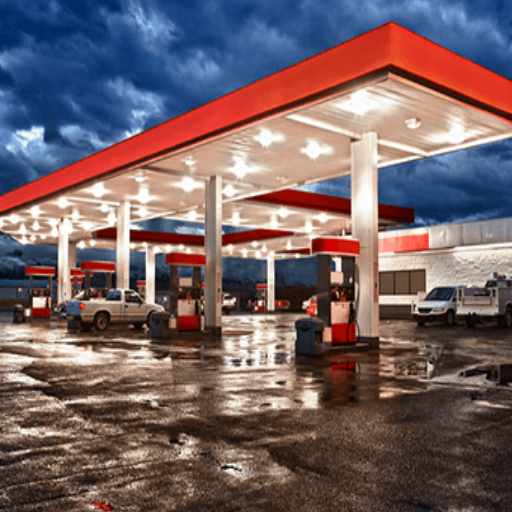
To build a gas station, proper permits and licenses must be obtained to comply with legal and safety requirements. Generally, this encompasses zoning permits, ensuring that a given area is suitable for a gas station; building permits, which approve construction plans before any work is undertaken; and environmental permits, which assess the potential impact on the immediate environment. Fire safety permits are also necessary to stipulate hazardous parameters for the storage and dispensing of fuel. Depending on the situation, specific licenses may be required by local, state, or federal entities; therefore, it is essential to consult local authorities to ensure that all aspects of the law are accounted for.
Essential Permits Required
To meet specific legal and regulatory requirements before opening and operating a petroleum retail outlet, several permits must be obtained. Zoning permits are typically issued to verify the suitability of the location, building permits ensure compliance with building laws, and environmental permits address the handling and storage of hazardous materials, such as fuel. Fire safety permits are necessary to mitigate risks associated with fuel storage and dispensing. Another permit you may require in some regions is for the underground storage tanks (USTs), whereas an air quality permit would allow emissions to be monitored. Regulations vary from local, state, and federal levels; therefore, make an effort to contact the respective authorities and adhere to the requirements of the specific jurisdiction.
Obtaining the Necessary Licenses
Licensing issues connected with dangerous materials, including fuel, consider the following steps to acquire the licenses and permits:
Research Local Regulations: To determine the permits required in your area, start your research with local government bodies or their websites. It may be that permits for fire safety, USTs, and air quality are required in your area.
Getting in touch with Authorities: In cases of uncertainty, consult local, state, and federal regulatory agencies. Depending on the jurisdiction, an agency could be a fire inspection bureau or an environmental protection department.
Prepare Documentation: Assemble all necessary documents, including site plans, safety protocols, and inspection reports, to ensure a comprehensive and accurate record. Each permit type is likely to have its own set of requirements, so be sure to check the details for submission correctness.
Submit Applications and Fees: Please submit the required application forms and fees. Always be thorough and accurate to prevent delays in the approval process.
Schedule Inspections: Site inspections are usually scheduled for approval. Before permits can be granted, you must address any corrective actions identified by the inspection.
Maintain Compliance: After procurement, licenses should be the object of one’s review of updated regulations that guide compliance. This is especially true for the handling of hazardous materials or the modification of facilities. Such permits must be renewed; otherwise, one risks penalties.
By taking these steps, you will be able to acquire the required licenses efficiently and remain compliant with applicable laws and regulations.
Compliance with Local Regulations
By local laws, businesses remain fit to operate legally and sustainably. Local governing bodies impose rules on zoning laws, worker safety issues, environmental protection, and tax phenomena, to cite just a few examples. For instance, industries dealing with hazardous substances may be subject to stricter environmental regulations, which must ensure the proper disposal of waste or restrict emissions with penalties or prohibitions concerning such chemicals.
The latest news indicates an increase in the oversight of environmental and labor compliance in several sectors. It is reported that in industrial operations last year, 30% of all penalties ensued from violations of worker safety laws, putting a new emphasis on protecting employee rights. Companies should conduct self-audits to ensure compliance with current laws and regulations, as well as monitor any changes that may arise in their jurisdiction. Training employees on best compliance practices will become paramount in the workplace as another means to maintain viability in the face of changing standards.
By working together with constant oversight and integrating compliance into the fabric of everyday activity, companies can mend their risk profile and thereby foster sustainability towards a coexistence cure within their local communities.
Understanding Construction Costs
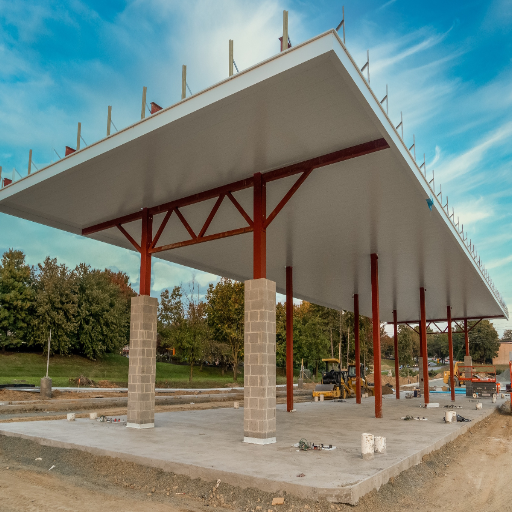
Costing a construction project involves identifying and managing all factors that contribute to its total expense. The primary items are labor, materials, equipment, permits, and overheads. Labor costs depend on the local workforce and wage rates. Material costs are sensitive to changes in market prices, specifically in terms of the required materials. Equipment costs cover the hiring, servicing, or purchase of machinery and equipment. Permit costs are fees charged to ensure compliance with local building codes and regulations. Overhead costs encompass all administrative and operational expenses necessary to ensure the project remains operational. Construction costs must be accurately estimated and effectively controlled through proper budgeting and planning.
Factors Affecting Gas Station Construction Costs
In the planning and budgeting of a construction project, understanding some of the vital components that can influence the cost of building a gas station is paramount:
Location: Depending on the area, land costs vary hugely. Urban or excellent-level locations will charge a premium. In contrast, rural locations might be far cheaper. Site-prep costs, however, might add up if there is some serious land work or environmental remediation to be done.
Size and Design: The construction of the gas station may require, depending on its size, the number of fueling pumps and other facilities such as car washes, convenience stores, or EV charging facilities, as well as the complexity of the architectural design.
Compliance and Permitting: Each area has to meet local zoning, environmental, and safety regulations. The permitting processes and costs for compliance could vary from region to region.
Material and Labor Costs: Variations in costs for materials, such as concrete, steel, and fuel tanks, as well as in wage levels for local skilled labor, can increase construction expenses.
Utilities and Infrastructure: The facilities should be equipped with utilities, including power, water, and a sewage system. The building cost can increase considerably if the utility infrastructure needs to be extended to the remote site.
Technological Features: The use of touchscreen payment kiosks, security surveillance, or energy-efficient systems may initially incur higher costs but will ultimately lead to longer-term savings or enhanced customer convenience.
If, before commencing construction, thorough planning and calculations are conducted on all the previously stated items, one may be able to identify cost-saving opportunities and keep the project within its budget without sacrificing the desired level of functionality and aesthetic value.
Detailed Breakdown of Station Construction Costs
Costs are broken down into detailed constituents in a typical construction of a station:
Site Preparation and Land Acquisition: This includes costs associated with the purchase or lease of land, as well as clearing, grading, and site stabilization for construction, with variations depending on location and topography.
Structural Construction: A core inspection of the foundation, structural steel, concrete, and roofing reveals that the design, size, and complexity of the station significantly influence these costs.
Utilities and Infrastructure: Constructing the water, electricity, and gas lines, as well as the sewer systems, forms a core part of construction. The installation of energy-efficient technology and renewable sources is expected to increase costs initially; however, it will ultimately lead to lower costs.
Architectural and Interior Finishes: These expenses relate to the construction of flooring, walls, lighting, and aesthetic finishes specific to the internal building design. It also includes all customer-facing finishes, such as ticketing counters and waiting areas, that aim to enhance the user experience.
Technology and Equipment: Modern technologies installed include automated ticketing, real-time screens, security cameras, and energy management systems, which can account for most of the costs.
Safety and Accessibility Compliance: Ensuring public safety and accessibility requirements include costs for fire suppression systems, elevators, and other necessary equipment, as well as ramps and other accessibility features.
Labor and Project Management: Good wages for construction crews, supervisors of contractors, and others involved in project management and coordination will significantly impact the budget.
A good bargain involves balancing the initial investment with sustainability and long-term cost savings while also prioritizing quality, safety, and convenience for end-users.
Budgeting for Fuel Pumps and Equipment
When preparing a budget for fuel pumps and other related equipment, several critical factors must be considered to ensure an efficient and accurate allocation of resources. The cost of fuel pumps varies enormously, depending on the type—whether above-ground or underground, single or multi-product dispensers, and brand option. Prices for a standard fuel dispenser may range between $15,000 and $25,000 per unit, with high-capacity specialty models costing $50,000 or more.
Another primary consideration would be the ancillary equipment, including storage tanks, piping, meters, and nozzles. Underground storage tanks may have prices ranging from $10,000 to $100,000, depending on size and material, with installation almost always adding a considerable cost; plus, environmental compliance equipment, like the vapor recovery system, can push the price up further, with other features added such as payment systems or remote monitoring systems, averaging between $5,000 and $10,000 per pump.
Maintenance and other operational costs must be included in the budget, including repairs and other expenses. From fuel system cleaning to periodic inspections and software updates for digital interfaces, good planning for recurring costs can help keep things running smoothly while avoiding bigger expenses down the road.
Other installation and labor costs are high-priced contributors, accounting for between 30% and 50% of the total project cost. They also vary significantly, depending on local regulations, site-specific challenges, and the scale of deployment. Extra costs may be incurred when designing energy-efficient systems or complying with safety standards; however, these should be offset by savings from reduced operational and energy costs over time.
Suppose these factors can be thoroughly studied, coupled with a diligent search for modern, cost-effective equipment. In that case, an adequate budget can be drafted that best matches business operations and industry needs.
Choosing the Right Gas Station Construction Company
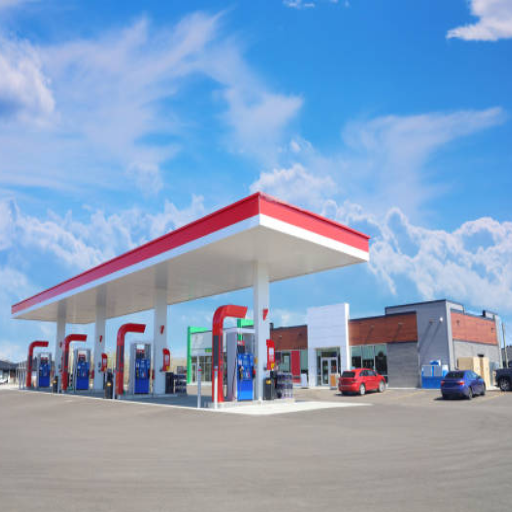
Selecting the right company for gas station construction ensures a successful project. Begin researching companies that have experience in constructing gas station facilities, giving weight to their industry expertise and reputation. Verification of their credentials, certifications, and knowledge of local regulations and safety criteria is recommended; references from previous clients should be requested to assess their local expertise and professionalism. Also, ask about their ability to complete projects on time and within budget. A company should be transparent in its communications, provide complete cost estimates, and offer a comprehensive schedule of expenses. Although many companies provide gas station construction services, always choose the firm that has the right expertise to overcome the challenges faced in gas station construction most efficiently.
How to Evaluate a Construction Company
When selecting a construction company, it is essential to highlight specific attributes and industry information to make an informed decision. Recent industry insights suggest that licensing and certification are one of the critical elements. The organization should ensure that the company holds all necessary state and industry certifications that conform to building standards and safety protocols.
Such a factor is highly prone to damage a reputation. The next step would be to search for online reviews on reputable platforms and review similar comments about quality, timeliness, and customer service. Approximately 72 percent of customers rely on online reviews and ratings to narrow down their choices. An award of recognition or membership in professional organizations, such as the Associated Builders and Contractors (ABC) or the Construction Management Association of America (CMAA), typically serves as a benchmark of high quality.
Experience in the actual kind of project for which you hire them is another valuable criterion. For instance, any company with years of experience in commercial or industrial construction realizes the enormity of pushing forward through a complex project. Contractors with more than 10 years of experience, however, are 25% more likely to deliver projects on time.
They also request information about your inquiry concerning their financial condition, as a financially distressed company can lead to an incomplete or untimely project. Request references for the finances or use methods to track how past projects have demonstrated their ability to handle budgets. A company that openly communicates its billing processes would most certainly gain that much more trust from clients.
Lastly, for judgment, check their safety reputation. This is because OSHA recommends evaluating a company’s safety programs and allows comparisons of incident rates, where lower incident rates are associated with higher proficiency and care in project execution. All these considerations, when combined, would lead to a straightforward choice that you can confidently make for your construction needs.
Specialized Gas Station Construction Companies
With a specialization in constructing gas stations, the firm designs and builds efficient, safe, and modern fuel stations tailored to the needs of its clients and customers. Hence, these companies generally incorporate advanced technologies into their construction projects, such as automated fueling systems, green structures, and digital payment systems. Given the current trends, there appears to be a growing demand for EV charging stations; hence, many companies now provide integrated solutions combining gasoline pumps and EV charging ports.
Recent data suggest that, from a global perspective, the fuel stations market is poised for remarkable growth, with a greater focus on sustainability and efficiency. Companies with expertise in constructing gas stations ensure that all aspects meet environmental regulations. They incorporate ecological features, such as underground storage tanks equipped with leak detection systems, vapor recovery systems, and solar-powered canopies. Due to varying complexities, locations, or sizes, timelines for project construction are usually 6 to 12 months.
Recent reports have highlighted that enhancing the customer experience is the top priority for gas stations today. Integrated convenience stores, efficient parking layouts, and automated maintenance systems present innovative solutions from the leading construction companies. Working with a specialist company ensures that your gas station is built according to the latest industry trends and regulations while also catering to the evolving tastes of today’s consumers.
Finding a Reliable Gas Station Contractor
When searching for a reliable gas station contractor, I always consider the industry experience and reputation the company has. Additionally, I would like to verify its compliance with regulatory standards. Notably, the firm has an outstanding reputation among its customers for its past projects and modern trends, such as sustainability and automation. Communication clarity and transparency about the budgeting procedure are other qualities that are important to me, as they ultimately lead to a smooth operation and a successful partnership.
Reference Sources
“Petroleum filling stations and their impact on the environment in Nigeria”
“Optimal planning of charging stations for phased electric vehicles”
“Assessment of Health, Safety, and Environmental Risks of Zahedan City Gasoline Stations”
Frequently Asked Questions (FAQs)
What are the key factors in gas station construction costs?
Gas station construction costs can vary widely based on several factors, including location, size, and the amenities offered at the site. The expenses may include land purchase, construction materials, labor, and compliance with environmental regulations. Additionally, costs can escalate if extensive demolition is required or if special permits and licenses are needed before construction begins.
How can I optimize the layout of my retail gas station?
To optimize the layout of a retail gas station, consider factors such as traffic flow, accessibility, and customer convenience. A well-planned layout can significantly enhance the customer experience, ensuring that fuel pumps are easily accessible and that the convenience store is strategically located to boost foot traffic. Engaging with a gas station contractor who specializes in retail service stations can help in designing an efficient layout.
What permits and licenses are required for opening a gas station?
Opening a gas station typically requires various permits and licenses that can vary by state and municipality. These may include environmental permits, business licenses, and zoning approvals. It is crucial to comply with local regulations to ensure a smooth construction process and avoid costly delays.
How does environmental safety impact gas station construction?
Compliance with environmental regulations is critical in gas station construction. This includes ensuring that the construction site meets safety standards to prevent leaks and spills of gasoline and diesel. Adhering to these regulations not only protects the environment but also enhances the long-lasting durability of the gas station, which can lead to a better return on investment.
What role does a gas station construction company play?
A gas station construction company plays a vital role in managing the entire construction process, from planning to execution. They bring extensive experience in navigating the specific challenges of constructing fuel centers, including coordinating with suppliers, managing labor, and ensuring compliance with industry regulations.
How can I boost profits at my gas station?
Boosting profits at a gas station can be achieved by maximizing service offerings and optimizing pricing strategies. Implementing a high-quality level of customer service, expanding amenities such as a convenience store, and regularly assessing fuel prices can attract more customers and increase profit margins. Additionally, effective marketing strategies tailored to the local market demand can enhance visibility and sales.
What is the average profit margin for retail gas stations?
The average profit margin for retail gas stations can vary, but it typically ranges from 1% to 3% on gasoline sales. However, profit margins can significantly increase through sales in convenience stores and other services offered at the station. By optimizing operations and enhancing customer experience, gas stations can achieve higher overall profitability.
What are the benefits of an upgraded fuel center?
Upgrading a fuel center can lead to improved customer satisfaction and increased sales. Modern upgrades may include advanced fuel equipment, enhanced safety features, and additional amenities that improve customer convenience. These enhancements can also help the station attract a larger customer base and strengthen its competitive edge in the petroleum industry.


